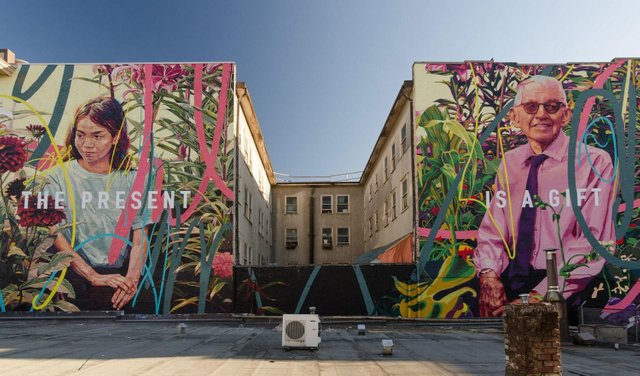Graffiti and Murals As Culture

Bujangan Urban 'in public spaces in Jakarta. In the early 2000s, Jablay founded Artcoholic, a community that focuses on street art. Then in 2007, he along with some friends founded Gardu House, a space for young people to share and provide facilities for those who intend themselves to live street art.
Similarly, Jablay, The Popo also started the process from small to pursue activities that he liked: drawing. When looking at Popo's work in the exhibition, it appears that the late father of the Popo has a great influence in the process of work. This is affirmed by Popo. He said that if we do not get the blessing of this family just as much as the community can not necessarily accept our work. At first, Popo's obstacle was a family that did not approve of his choice to become an artist. But slowly Popo was able to prove it. He helped build and support Kampung Segart, a student activity unit that focuses on art at the Institute of Social and Political Sciences in Jakarta. Transformation, currently some members of the editorial VJ is a child who used to once joined in Segart.
If Bujangan Urban and The Popo are individuals who indeed decide the streets as a battle space to work, it is different from MG Pringgotono (eemjie). In this exhibition, Eemjie with City Artistic Office (DAK), create a mini museum featuring street art moment moment in Jakarta. He created a model containing works by street artists. When I asked why I chose the Popo, Bujangan Urban, and some artists, Eemjie replied that he was inspired by the story behind the making of the work. For example, the work of The Popo Correct Prohibited! he chose because the mural involves the override process performed by the Popo and reciprocated by the local police.

Inspiration of Young People
No doubt, Urban Bachelor and The Popo is a source of inspiration for young people today. Bujangan Urban with Gardu House can earn trust, while The Popo is indeed active in social media to become the idol of young people now. Their existence in the art world can not be separated from the support of his fans. Even as artist talks take place, questions and responses revolve around how to become a street artist who can survive for more than a decade.
The first response came from Jun. He questioned about tiban-meniban or the process of overwriting the work with tagging, other works, or painting done by the Local Government through Satpol PP. For Popo, he never questioned anyone else who befell his work. He is quite open and legawa. Nor is Urban Bujangan. For him, the walls and public space in Jakarta are still many. It does not matter. But Urban Bajangan adds that if anything happens to someone else's murals or graffiti, the person's signature does not respect others. Overwrite is widely encountered. Unfortunately this is for Bujangan Urban is the most widely used way for beginners to become famous on the streets.
Then there was Vido from Bekasi who asked about the defense strategy for the street artists. Adapula El from Trisakti University, Jakarta is asking for advice for young people who want to plunge into the world of street art. Both Urban Bachelors, Popo, and Eemjie smiled at this question. Both of these questions are addressed with Bujangan Urban who affirm that in Indonesia has a special type. Spray can be expensive, but the trick can still be done so that the process of work continues to run. He also added that to be a street artist, first must be honest with himself and also able to respect others. Working on the streets is different from working in showrooms or galleries because the artist will deal with the citizens or the apparatus, who may not like their work. It takes courage to deal with tension during work on the streets and public spaces.
The fight will be more fierce
The spirit to work on the streets is visible from the eyes of the young people present in this artist's talk show. Inspired by the story of the Popo and Gardu House, it may be that many are hooked to make mural and graffiti on the roadside. New seeds will always appear, and later, affirming the Bujangan Urban statement, "street art is culture", will come true. But before this was done, these beginners were overshadowed by local government decisions, especially those currently seen in Jakarta, regarding the prohibitions on street and public spaces. Problematic because when young people have the spirit to work, the space is not given by the government. Public space is even given to the corporation.
In response to the dilemma, Eemjie is optimistic. As an observer of street art development in Jakarta as well as artists deepening urban problems, Eemjie sees that street art can be used as a medium for a voice, a criticism-each individual has his or her own way. The statement as confirmed in the Free but Polite exhibition. The question of government policy he poured through the City Artistic Service, an art project that has a goal to make the city more artistic. Through the eyes of DAK, the stretching of these street artists should be embraced by the government. Unfortunately, the sheer amount of development and uncertainty of who is managing billboards and roadside advertising banners makes the visual battle even more fierce. For this reason, mapping and re-listing of what happens on our streets should be done, in the hope that policymakers are able to read and make the city a "habitable" place for its citizens.
License From visualist